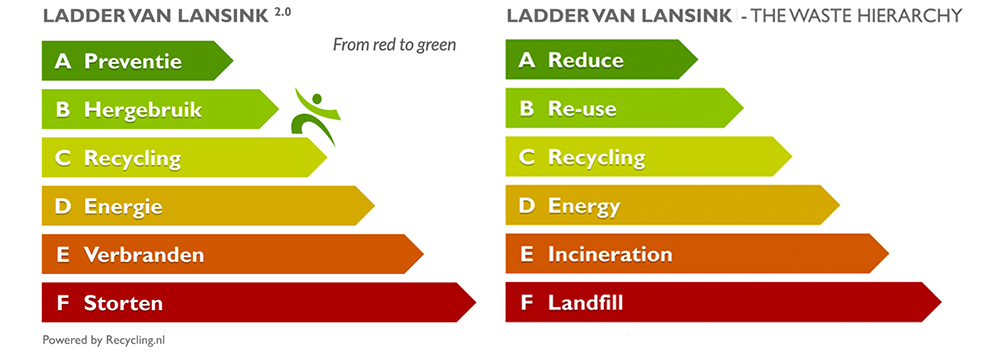Lansink's Ladder
Lansink's ladder is said to have formed the basis of the waste hierarchy or waste management hierarchy. Conceived as a ladder of decision steps it distinguishes five forms of waste management: prevention, reuse, sorting/recycling, incineration and landfilling.
The ladder or steps were later translated to a triangle running in the same order (perhaps because of similarity with energy ratings symbols), with prevention at the top, but it may also now be seen as an inverted triangle with prevention at the top, at its widest, indicating the level of impact each approach might have, ie prevention has the highest level of impact on the overall issues. Ironically, until recently, statistics show that globally incineration and landfill in most countries continues to outweigh other forms of management in terms of what is actually done.
The Ladder of Lansink was adopted in 1979, significantly impacting Dutch waste policy, the Environmental Management Act in 1993, and the European Waste Framework Directive 2008. The Netherlands remains one of the Nations in Europe with the highest rates of recycling.
Ad Lansink worked as a Senior Lecturer in Physical Chemistry at the University of Nijmegen, as Biochemist at the Pathology Department of the UMC Radboud, becoming politically active in the Catholic People’s Party. In the 1977 he was elected to the Dutch parliament and worked on topics such as environment, energy, higher education, science policy and public health. After his parliamentary career, he became a member of the Advisory Board for the state-owned company for the storage of radioactive waste and worked as the Chairman of the Gelderland Environment Federation.
For further information visit https://www.adlansink.nl (in dutch)
[edit] Related articles on Designing Buildings
- Bin blight.
- Circular economy.
- Quantification of construction materials in existing buildings (material intensity).
- Plastic and recycling.
- Recycled waste plastic in construction.
- Recyclable construction materials.
- Recycling.
- Reduce, reuse, recycle.
- Reused construction products.
- UandI Think event with Studio SWINE.
- Waste management plan for England.
- Waste hierarchy for construction
Featured articles and news
One of the most impressive Victorian architects. Book review.
RTPI leader to become new CIOB Chief Executive Officer
Dr Victoria Hills MRTPI, FICE to take over after Caroline Gumble’s departure.
Social and affordable housing, a long term plan for delivery
The “Delivering a Decade of Renewal for Social and Affordable Housing” strategy sets out future path.
A change to adoptive architecture
Effects of global weather warming on architectural detailing, material choice and human interaction.
The proposed publicly owned and backed subsidiary of Homes England, to facilitate new homes.
How big is the problem and what can we do to mitigate the effects?
Overheating guidance and tools for building designers
A number of cool guides to help with the heat.
The UK's Modern Industrial Strategy: A 10 year plan
Previous consultation criticism, current key elements and general support with some persisting reservations.
Building Safety Regulator reforms
New roles, new staff and a new fast track service pave the way for a single construction regulator.
Architectural Technologist CPDs and Communications
CIAT CPD… and how you can do it!
Cooling centres and cool spaces
Managing extreme heat in cities by directing the public to places for heat stress relief and water sources.
Winter gardens: A brief history and warm variations
Extending the season with glass in different forms and terms.
Restoring Great Yarmouth's Winter Gardens
Transforming one of the least sustainable constructions imaginable.
Construction Skills Mission Board launch sector drive
Newly formed government and industry collaboration set strategy for recruiting an additional 100,000 construction workers a year.
New Architects Code comes into effect in September 2025
ARB Architects Code of Conduct and Practice available with ongoing consultation regarding guidance.
Welsh Skills Body (Medr) launches ambitious plan
The new skills body brings together funding and regulation of tertiary education and research for the devolved nation.
Paul Gandy FCIOB announced as next CIOB President
Former Tilbury Douglas CEO takes helm.























